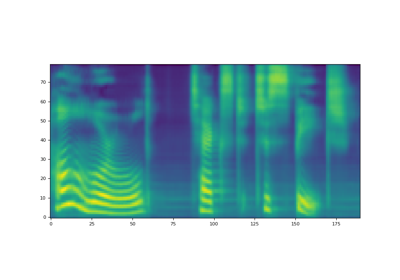WaveRNN¶
- class torchaudio.models.WaveRNN(upsample_scales: List[int], n_classes: int, hop_length: int, n_res_block: int = 10, n_rnn: int = 512, n_fc: int = 512, kernel_size: int = 5, n_freq: int = 128, n_hidden: int = 128, n_output: int = 128)[source]¶
WaveRNN 模型,来自《高效神经音频合成》(Efficient Neural Audio Synthesis)一文 [Kalchbrenner 等人,2018],基于 fatchord/WaveRNN 的实现。
原始实现首次在《高效神经音频合成》(Efficient Neural Audio Synthesis)一文中提出 [Kalchbrenner 等人,2018]。波形和谱图的输入通道数必须为 1。`upsample_scales` 的乘积必须等于 `hop_length`。
另请参阅
torchaudio.pipelines.Tacotron2TTSBundle:包含预训练模型的 TTS 流水线。
- 参数:
upsample_scales – 上采样尺度的列表。
n_classes – 输出类别的数量。
hop_length – 连续帧起始点之间的样本数。
n_res_block – 堆叠中的 ResBlock 数量。(默认值:
10)n_rnn – RNN 层的维度。(默认值:
512)n_fc – 全连接层的维度。(默认值:
512)kernel_size – 第一个 Conv1d 层中的核大小。(默认值:
5)n_freq – 谱图中的 bin 数量。(默认值:
128)n_hidden – resblock 的隐藏维度数量。(默认值:
128)n_output – melresnet 的输出维度数量。(默认值:
128)
- 示例
>>> wavernn = WaveRNN(upsample_scales=[5,5,8], n_classes=512, hop_length=200) >>> waveform, sample_rate = torchaudio.load(file) >>> # waveform shape: (n_batch, n_channel, (n_time - kernel_size + 1) * hop_length) >>> specgram = MelSpectrogram(sample_rate)(waveform) # shape: (n_batch, n_channel, n_freq, n_time) >>> output = wavernn(waveform, specgram) >>> # output shape: (n_batch, n_channel, (n_time - kernel_size + 1) * hop_length, n_classes)
- 使用
WaveRNN的教程
方法¶
forward¶
- WaveRNN.forward(waveform: Tensor, specgram: Tensor) Tensor[source]¶
将输入通过 WaveRNN 模型。
- 参数:
waveform – WaveRNN 层的输入波形(n_batch, 1, (n_time - kernel_size + 1) * hop_length)
specgram – WaveRNN 层的输入谱图(n_batch, 1, n_freq, n_time)
- 返回值:
形状为 (n_batch, 1, (n_time - kernel_size + 1) * hop_length, n_classes) 的张量
- 返回类型:
Tensor
infer¶
- WaveRNN.infer(specgram: Tensor, lengths: Optional[Tensor] = None) Tuple[Tensor, Optional[Tensor]][source]¶
WaveRNN 的推理方法。
此函数目前仅支持多项式采样,这假定网络是在交叉熵损失上训练的。
- 参数:
specgram (Tensor) – 批处理的谱图。形状:(n_batch, n_freq, n_time)。
lengths (Tensor 或 None, optional) – 指示批处理中每个音频的有效长度。形状:(batch, )。当
specgram包含不同时长的谱图时,通过提供lengths参数,模型将计算相应的有效输出长度。如果为None,则假定waveforms中的所有音频都具有有效长度。默认值:None。
- 返回值:
- Tensor
推理出的波形,大小为 (n_batch, 1, n_time)。1 表示单通道。
- Tensor 或 None
如果提供了
lengths参数,则返回形状为 (batch, ) 的 Tensor。它指示了输出 Tensor 在时间轴上的有效长度。
- 返回类型:
(Tensor, Optional[Tensor])

